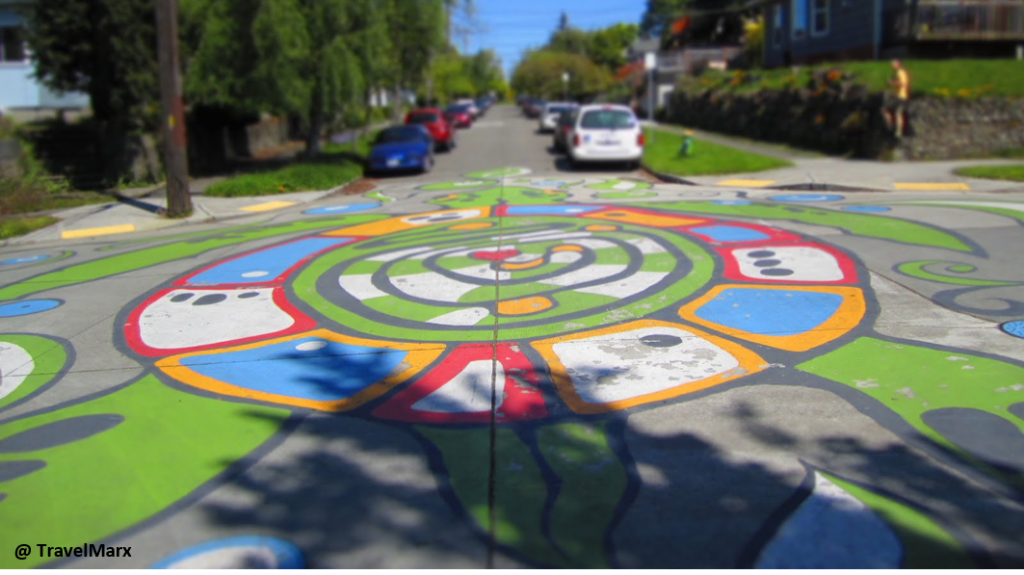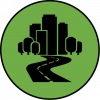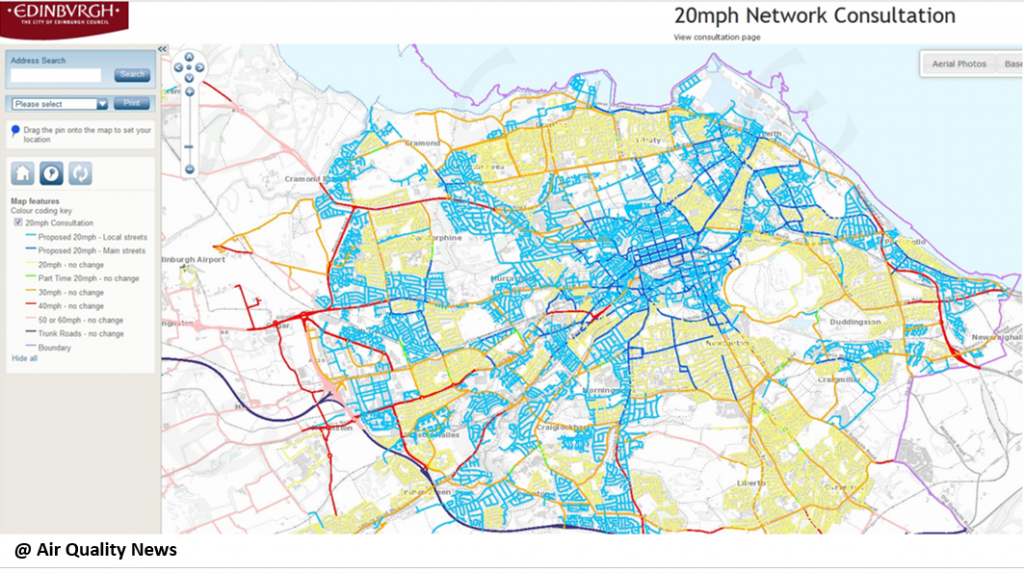
1. Presentation
This measure entails the implementation of limited speed zones (20 to 30 km/hour) and the logistic/supervision system required to enforce them. It creates privileged zones, where the road space is shared between cars and bicycles, by reducing the speed to levels compatible with the bicycle. In this manner, the so called “invisible”, and therefore less expensive, cycling infrastructure is expanded.
(See also other traffic calming measures: Horizontal and vertical road deflections; Road narrowing; Car connectivity restrictions; Limited car access areas; Car free zones)
2. Objectives
- Reducing vehicular speed;
- Reducing the number and gravity of accidents;
- Reducing air and noise pollution;
- Eliminating/reducing local traffic created by drive-through vehicles;
- Controlling the volumes of motorized traffic in certain sections or critical areas.
3. Measure´s Importance
The creation of limited speed zones is fundamental to promote behaviour compatibility between the different means of transportation (motorized and non-motorized), thus assuring the best possible co-existence in the same space. It is a relatively effective way to adapt the physical context to the user’s actual needs, thus promoting bicycle use.
1. Good Practices
– The implementation of limited speed zones should be included in a comprehensive programme that includes traffic calming measures, speed limits reduction, driver’s education and enforcement measures.
– Complement with different types of traffic calming measures and different actions inside each measure (See Horizontal and vertical road deflections; Road narrowing; Car connectivity restrictions; Limited car access areas; Car free zones).
– The planning of this interventions should include the adequate participation and involvement of the users.
– Account for the different street uses, including drive-by trips, recreational trips, socializing, trading and proximity services. These activities should be considered and balanced in the design of the intervention areas.
– The intervention should respond to multiple objectives, including the improvement of public space, the creation of better pedestrian and cycling conditions and traffic speed control.
– The new information and control devices should be adequately implemented, to alert to the new conditions and indicate the new routes and rules vehicles must abide by.
– Monitor the citizen adaptation to the alterations and continuously reformulate the measure in order for them to answer the citizen’s needs, without compromising the sustainable ideals (See Management, monitoring and maintenance).
– Clarify the principles behind the implemented measures in order to comprehensively justify their need and functioning (See Information).
2. Actions
 | 30 Zones The concept of 30 Zones is structured around the reduction of motorized traffic volumes and the improvement of the safety conditions for pedestrian and cyclists trips through the imposition of a low speed limit and urban design measures. The 30 km/h speed limit aims to progressively alter the driver’s behaviours, fostering a safer, quieter and less polluting circulation; and allowing a more equitable use of public space. This solution is indicated in local access streets, located in residential, central or suburban areas, where streets clearly perform an accessibility function. The legal speed alteration must imperatively be accompanied by physical traffic calming measures (See Horizontal and vertical road deflections; Road narrowing; Car connectivity restrictions; Limited car access areas; Car free zones) and/or permanent enforcement measures to ensure the desired effect. |
 | 20 Zones Em determinadas áreas, é recomendável a limitação da velocidade a 20 km/h, In determinate areas, it’s advisable to limit the speed to 20 km/h, namely around schools. In these situations, the pedestrians, cyclists and other non-motorized means of transportation have priority and can cross the streets where they see fit. Some European countries designate these areas as “meeting zones”. Learn more: www.mobilservice.ch/admin/data/files/news_section_file/file/3731/bfu-2013_fachbroschuere-begegnungszonen_fr.pdf?lm=1456248257 |
The implementation of 20 Zones or 30 Zones can be reinforced through speed control measures (such as speed control traffic signals and radars), permanent enforcement measures and complementary traffic calming measures (See Horizontal and vertical road deflections; Road narrowing; Car connectivity restrictions; Limited car access areas; Car free zones).

In Portland, Seattle, certain neighborhoods are introducing pavement paintings in order to influence the drive to reduce his speed. These painting are used mainly in intersections, to alert the drivers to slow down. In this specific case, in Wallingford, an artist was hired to create the original drawing, but it was the neighborhood that organized itself in order to raise the budget and the permits needed. The neighborhood was also in charge of painting the original intervention and arranging for its maintenance. Overall, the project cost 1 200,00$ and was paid for in part by a city fund.
Learn more: https://cityrepair.org/
1. Impacts
 | Mobility system efficiency By discouraging car use, it reduces traffic congestion and facilitates walking and cycling. However, by reducing speed traffic, it can generate some congestion points. |
 | Livable streets Focusing in active means of transportation favours organizing public urban space in a way that avoids conflicts. The streets are safer, more active and more dynamic with the increase in cyclists circulation. |
 | Protection of the environment By favouring the alteration from car to bicycle, it influences the mitigation of air and sound pollution. |
 | Inclusion, equity and accessibility Traffic calming measures assure improvements in the accessibility and travel options for alternative transportation users. |
 | Safety and comfort Vehicle speed reduction enhances pedestrian and cyclist safety. |
 | Economic value Favours access to stores and proximity services. However, limited speed areas can be less attractive to drivers of motorized vehicles. |
 | Awareness and acceptability There is evidence that the presence of cyclists promotes bicycle use. Therefore, the inclusion of traffic calming measures can influence more sceptical groups to cycle more frequently. |
Legend:
| Very positive | Positive | Neutral | Negative | Very negative |
2. Barriers
 | Legal Countries where there’s no legal framing and guidance on this kind of measures may encounter legal barriers. |
 | Finance Limited speed zones can be implemented at low cost, especially when compared to the construction of mew road infrastructure or public transportation. However, the more complex the materials and design, the higher the cost will be. |
 | Governance Traffic calming measure can generally be implemented by a single department of a single authority. |
 | Political acceptability Any perceived reduction in the accessibility can be controversial for both residents and non-residents. However, the continuous spread of traffic calming measures indicates this is a measure that can be resolved. Studies demonstrate that most people that live in areas with traffic calming measures are satisfied. |
 | Public acceptability The acceptance by the local community and the cooperation with relevant institutions are fundamental to the viability of the measure. Aesthetic and precise location are frequently important factors to public acceptance. |
 | Technical feasibility Several traffic calming measures demand specific technical knowledge. |
Legend:
| No barrier | Minimum barrier | Moderate barrier | Significant barrier |
3. Budget
| Area | Measure | Unit | Cost | Implementation year |
| Seixal, Lisbon Metropolitan Area (Portugal) | Acquisition of speed control traffic lights | 2 | 14 225,00 € | 2018 |
Case study 1: 20 mph zones in Edinburgh (Scotland)

In its 2000 local transportation strategy, the city of Edinburgh set itself to reach the national goal of a 40% reduction in the number of dead or severely injured in traffic accidents. The city used traffic calming, mainly implementing self-enforcing 20 mph zones (through the use of speed humps).
Impact:
 | Mobility system efficiency No data. |
 | Livable streets 78% of residents supported the idea before and after its implementation. |
 | Protection of the environment No data. |
 | Inclusion, equity and accessibility No data. |
 | Safety and comfort Data based on the three years prior and later and on the 112 traffic calming schemes implemented shows: • A 36,6% reduction in collisions with injuries in residential areas. • A 35,9% reduction in collisions with injuries near schools. • A 42% reduction in collisions with injuries in residential areas. • A faster reduction than in the remaining Scotland cities during the same time period. |
 | Economic value No data. |
 | Awareness and acceptability No data. |
Legend:
| Very positive | Positive | Neutral | Negative | Very negative |
IMPIC. Base: Contratos públicos online. Accessed 7 July 2019. Available at: http://www.base.gov.pt/Base/pt
IMTT (2011). Princípios de Planeamento e Desenho. Colecção de Brochuras Técnicas / Temáticas Rede Ciclável. Accessed 3 July 2019. Available at: http://www.imt-ip.pt/sites/IMTT/Portugues/Planeamento/DocumentosdeReferencia/PacotedaMobilidade/Documents/Pacote%20da%20Mobilidade/Rede%20Cicl%C3%A1vel_Princ%C3%ADpios%20de%20Planeamento%20e%20Desenho_Mar%C3%A7o%202011.pdf
KonSULT. Knowledgebase on Sustainable Urban Land use and Transport. (2014). Traffic Calming Measures. Accessed 6 February 2019. Available at: http://www.konsult.leeds.ac.uk/pg/13/
Nunes da Silva, F., & Lajas Custódio, R. (2013). Zonas 30 – segurança rodoviária, vida e vitalidade para os bairros da cidade de lisboa. 7o Congresso Rodoviário Português (pp. 1–11).
InIR. Instituto de Infraestruturas Rodoviárias. (2011). Medidas de Acalmia de Tráfego (Vol.1) – Medidas Individuais Aplicadas em Atravessamentos de Localidades, Disposições Normativas.
Pereira, P. C. (2014). Devolver as Cidades às Pessoas. Accessed 6 February 2019. Available at: http://transportesemrevista.com/Default.aspx?tabid=210&language=pt-PT&id=40088
Pereira, J. (2013). Medidas de acalmia de tráfego em áreas urbanas consolidadas: Um caso no concelho do Seixal. Faculdade de Ciências Sociais e Humanas da Universidade Nova de Lisboa e Universidade Atlântica.
Department for Transportation (2005) Home Zones: Challenging the Future of Our Streets, London DfT.
